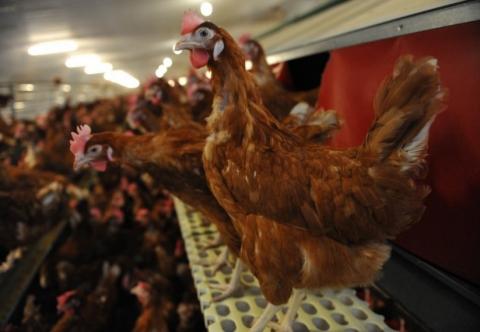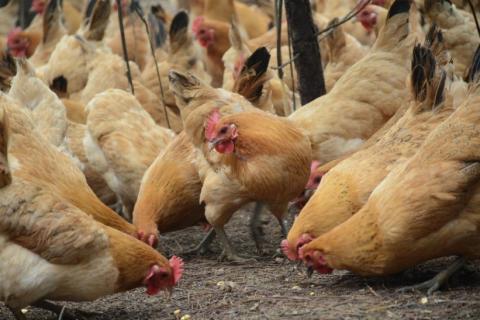Poultry manure management
Take home messages:
- Poultry manure is rich in nutrients making it an effective fertiliser.
- Initial composting can improve the nutrient composition of this material.
- Guidance should be sought from the APHA before moving it between farms.
Poultry production is a growing sector of agriculture in the UK, due to the increasing demand for poultry meat and egg products. Poultry manure is a by-product of this production and is rich in nutrients, which can provide a major source of nitrogen (N), phosphorus (P) and trace elements for crop production. This material can also improve physical and biological fertility of soil, making it ideal for land application as a fertiliser.
The availability of poultry manure is growing rapidly, particularly in Wales, making its usage in agricultural production more commonplace. However the effectiveness of poultry manure as a fertiliser has been questioned due to low carbon (C):P and N:P ratios and the high potential for loss of N and P through leaching. In addition, overuse or unplanned applications can result in nutrient saturation and consequently environmental loss. Initial soil testing and defined nutrient management plans for fertiliser application are therefore essential.
Finding effective ways to manage this potential resource is therefore of key importance to enable a strategy for effective waste management, and also to maximise farm business efficiency.
Composting poultry manure:
Composting poultry manure prior to application can potentially improve nutrient constituent ratios and produce a more predictable and reliable source of N and P, which remains as available after composting as in the fresh litter material. Composting poultry manure might have additional benefits such as the decomposition of veterinary drugs. This may be an important factor as the uptake of veterinary medicines by plants has been reported as a potential consequence from the use of poultry manure.
Different feedstock materials for composting alongside poultry manure have been trialled to attain optimum nutrient ratios. In a study comparing different feedstock materials, compost produced from mixing poultry manure with wood chippings and bark (42.5%), wheat straw (30%) and grass clippings (20%) had the highest quality as a soil improver in terms of organic matter content, C:P ratio, C:N ratio and stability. Interestingly, the poultry manure component was relatively small (7.5%) in order to achieve optimum nutrient ratios. Other studies have demonstrated the effective use of a higher rate of inclusion of poultry manure. In one, a mixture of 83% poultry manure and 17% wheat straw (dw) provided the best conditions for the composting process out of three ratios tested (the others were: 73.5% manure/26.5% straw and 88% manure/12% straw). Nevertheless, the addition of C rich material is necessary to avoid low C:N ratios in the compost mixture, which may inhibit the composting process. Temperatures generated by this mixture during composting were also shown to be sufficient for pathogen removal.
Alternative uses for poultry manure:
Spreading fresh manure on the land can result in emissions of greenhouse gases (GHGs), such as N2O. Alternative strategies for using the manure material could be the generation of electricity. This reduces the emission of GHGs from the manure and also reduces the emissions of GHGs associated with fossil fuel combustion. In addition, the resultant ash is rich in P and K and can still be used as a fertiliser. The use of biochar derived from poultry manure has also been shown to be effective for use as a fertiliser in bean and maize crops. This approach may offer a mechanism to reduce the problems associated with use as a fresh manure, whilst also generating energy and subsequently increasing C storage in soil after application.
Nutrient management planning and factors to consider:
 Due to a variable composition, unprocessed (or ‘green’ manure) presents several difficulties in terms of even spread of nutrients during land application. In addition, the high levels of N and P means that application rates must be restricted to avoid nutrient leaching. Long-term applications of poultry manure may also affect soil P status, ultimately leading to losses of P.
Due to a variable composition, unprocessed (or ‘green’ manure) presents several difficulties in terms of even spread of nutrients during land application. In addition, the high levels of N and P means that application rates must be restricted to avoid nutrient leaching. Long-term applications of poultry manure may also affect soil P status, ultimately leading to losses of P.
Poultry manure from different poultry farming systems varies in composition due to the nature of farming practices between systems. Poultry litter from floor-raised birds (broilers, turkeys, broiler breeder pullets) consists primarily of droppings and bedding (usually wood shavings or sawdust). Feathers and waste feed make up the remaining litter components. Poultry manure consisting of only faecal droppings is associated with caged layers and broiler breeders. A study of poultry manures from different systems from across the UK showed that, in general, broiler/turkey litters had a higher dry matter content (c.60%) than layer manures (c.35%), although all manure types had similar concentrations of nutrients (N, P, K, Mg, S) on a dry weight basis. Typically N:P:K ratios were 6:2:2 for layer manures and 6:2:3 for broiler/turkey litters.
Current rules/regulations on the use of poultry manure:
According to information on GOV.UK: to sell manure there are several stipulations which must be met. For
sale in the EU, it must first be treated at an approved processing plant, where manure must be heated to 70°C for at least 60 minutes. Approval must also be sought from the Animal and Plant Health Agency (APHA). It is possible to use alternative methods of processing, but these will need to be ratified by the APHA and subsequent analysis of the resultant material (including tests for bacteria, virus and parasite presence) will be required.For sale in the UK, partially processed material can be sold. Approval will still be needed from the APHA for this practice. However, the distribution of material which isn’t commercially exchanged may still be acceptable. The website stipulates that ‘you can spread poultry manure on your own land or supply it for use on other farms and markets gardens if you take the following steps to avoid the spread of botulism: inspect your birds regularly and remove any dead ones from the litter immediately so carcasses don’t end up in the manure; don’t dispose of feathers or cracked eggs in your manure (some feathers will naturally fall into the litter but don’t dump bulk quantities, e.g. after the slaughter of turkeys at Christmas)’.
The burning of poultry manure in a combustion unit also requires prior application to the APHA. It is recommended therefore that guidance is sought before commencing with the movement of manure between farms or any other distribution activities.
Summary
The growth of poultry production within the agricultural industry, both in the UK and globally, will ensure supplies of poultry manure will also grow concurrently. A major challenge for this growing sector is the management of this substantial waste burden, which, if managed correctly, is a valuable resource of nutrients.
Poultry manure has the potential to be a highly effective fertiliser, as it has a high nutrient content. The use of green manure may however be problematic due to the relative ratios of nutrients within this material. Initial composting of this material can improve these characteristics and the resultant compost material can be stored for longer periods and is easier to apply in field than unprocessed chicken litter.



